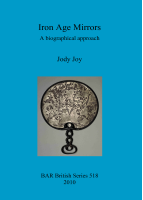Description
BOOK DESCRIPTIONMirrors are amongst the most well known British Iron Age objects. They are of a type which is peculiar to Britain and are significantly different in form from contemporary Greek, Etruscan and Roman forms. 58 mirrors are known. They are made of bronze andiron, or sometimes a combination of bronze and iron components. Mirrors comprise a handle and a reflective plate, which is often decorated with intricate and free-flowing designs. Some plates are also rimmed. Mirrors are found throughout Britain; two have been discovered in Ireland and two others are known from the continent. They are most commonly found in graves; but were also deposited in bogs and rarely at settlements. They date to the mid-late Iron Age. This book tests the applicability of the biographical approach to prehistoric objects and the application of the biographical approach to prehistoric material culture is evaluated by constructing biographies for Iron Age mirrors. This study is divided into three main sections. In the first section mirrors are introduced as is the theoretical methodology (Chapter 2). Chapter 1 explains what mirrors look like, the contexts they are found in and how they have been studied in the past to pinpoint what we do not yet understand about them and what needs further clarification. In Chapter 2 the biographical approach to artefacts is outlined; how it has been used in archaeology and how the approach will be utilised to expand our knowledge of mirrors and the broader Iron Age context by reconstructing the relationships that constitute mirrors and their biographies. Chapter 3 examines evidence for the production of Iron Age metal artefacts as well as investigating the context of the production of metalwork in ethnographic contexts. The aim is to develop an understanding of the technology of mirror production, the relationships established through their production and the potential future trajectories of the life of a mirror set out at the time of manufacture. In Chapter 4 mirror decoration is examined. Chapter 5summarises the results of a programme of visual examination of the physical condition of surviving mirrors. Over 30 mirrors were examined for signs of wear, polishing and repair; clues which can indicate how mirrors were used and inform us about their social lives. Chapter 6 examines the form of mirrors. In the third section deposition context is examined. Chapter 8 is the first comprehensive dating audit of all Iron Age mirrors. In Chapter 9 all of the deposition data is collected. Chapter 10 is an analysis of the results of Chapter 9. In Chapter 11 the implications of these findings for wider research and the future of the application of the biographical approach to archaeological research, is assessed.











